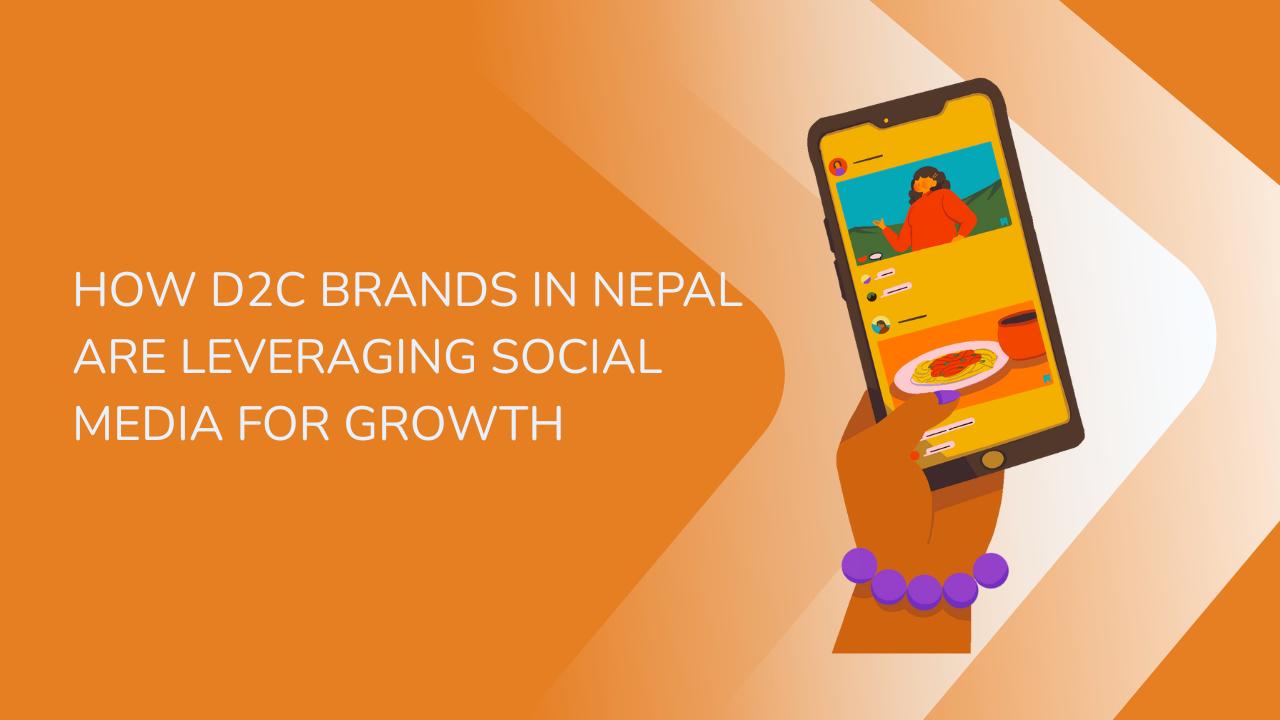Share this Article
In the rapidly changing retail landscape of Nepal, Direct-to-Consumer (D2C) brands are emerging as key players, capitalizing on the power of social media to reach and engage with their target audiences. Traditional retail channels are no longer the sole method of reaching consumers, as D2C brands directly connect with their audience, bypassing middlemen. The rise of social media platforms has made this direct approach more accessible, creating opportunities for small and medium-sized businesses to scale. In this article, we will explore how D2C brands in Nepal are leveraging social media strategies to fuel their growth, build brand awareness, and boost sales.
1. Understanding the D2C Model in Nepal
Before diving into the specifics of social media strategies, it’s important to understand what the D2C model entails and why it is gaining traction in Nepal. Traditionally, retail businesses relied on distributors, wholesalers, and retailers to sell their products. However, with the rise of digital marketing and e-commerce platforms, the D2C model has become increasingly popular.
In a D2C business model, companies sell their products directly to the consumer without relying on intermediaries. This direct connection not only allows businesses to have more control over their brand narrative but also creates better opportunities for personalized customer experiences. In Nepal, the D2C model is becoming more prevalent, particularly among small businesses and startups.
The ability to use social media as a tool for engagement and sales is a huge advantage for these brands, especially in a country like Nepal, where digital literacy is rapidly increasing. Social media has become the go-to platform for marketing, sales, and customer service, making it essential for D2C brands to adopt effective social media strategies to remain competitive.
2. The Role of Social Media in Modern Marketing
Social media has evolved far beyond its original purpose of socializing and sharing personal updates. Today, platforms like Facebook, Instagram, Twitter, and TikTok have become integral parts of the marketing ecosystem, with millions of users across Nepal and the world. The massive user base on these platforms allows D2C brands to connect with a wide audience, target specific customer segments, and generate engagement at a scale previously unimaginable.
For D2C brands, social media is not just a platform for advertisement; it is a space where they can foster relationships with their customers, promote their products, build brand loyalty, and create a sense of community around their brand. Social media allows brands to tell their stories, showcase their products, and provide customer support—all in real-time. This direct interaction is key to building trust and credibility, especially in Nepal’s evolving market.
3. Social Media Strategies Used by D2C Brands in Nepal
D2C brands in Nepal are taking full advantage of the power of social media, using a variety of strategies to engage with consumers and grow their businesses. Here are some of the most effective social media strategies being employed:
a) Influencer Marketing
Influencer marketing has emerged as one of the most effective ways for D2C brands in Nepal to build brand credibility and reach a wider audience. By partnering with local influencers who have large, engaged followings, brands can promote their products in an authentic way. Influencers in Nepal have become key opinion leaders, with their recommendations often influencing consumer purchasing decisions.
D2C brands collaborate with influencers to create content such as product reviews, unboxing videos, tutorials, or sponsored posts. The power of influencer marketing lies in its ability to tap into the influencer’s established trust with their followers, making it easier for brands to introduce their products to potential customers.
b) Content Marketing and Storytelling
Social media is all about storytelling. D2C brands in Nepal use platforms like Instagram, Facebook, and YouTube to share the story behind their products and the brand itself. They focus on creating content that resonates with their target audience, whether it’s through inspirational posts, educational videos, or behind-the-scenes looks at their production process.
By creating high-quality, engaging content that tells a story, D2C brands are able to build stronger emotional connections with their audience. Whether it’s showcasing the craftsmanship behind a handmade product or sharing the mission and values of a brand, storytelling allows businesses to differentiate themselves and stand out in a crowded market.
c) Paid Advertising
While organic reach on social media is important, paid advertising offers D2C brands in Nepal the ability to scale their marketing efforts quickly and target very specific demographics. Social media platforms like Facebook and Instagram offer powerful targeting tools that allow businesses to reach users based on factors like location, interests, age, gender, and behavior.
Paid ads are an essential part of the marketing mix for D2C brands looking to grow their presence and drive sales. Whether it’s through carousel ads, sponsored posts, or story ads, these paid campaigns allow brands to increase visibility, attract new customers, and drive conversions. Given the high engagement rates on platforms like Instagram, ads placed strategically can yield great returns.
d) User-Generated Content (UGC)
User-generated content (UGC) is another powerful social media strategy that D2C brands in Nepal are embracing. UGC refers to content created by customers, such as reviews, photos, and videos featuring the brand’s products. By encouraging customers to share their experiences with a product on social media, brands can leverage social proof to build trust and authenticity.
D2C brands often create hashtags or social media challenges to encourage customers to share their content. This type of content is incredibly valuable because it acts as word-of-mouth marketing, helping to expand the brand’s reach and attract new customers. Sharing UGC on official brand accounts also boosts customer loyalty, as it makes customers feel valued and appreciated.
e) Social Commerce
Social commerce, or the ability to purchase products directly through social media platforms, has become a growing trend among D2C brands in Nepal. Platforms like Instagram and Facebook allow brands to set up shop directly on their pages, enabling users to browse and purchase products without leaving the app.
This streamlined shopping experience not only makes it easier for consumers to make purchases but also reduces friction in the buying process. Social commerce is particularly effective for brands looking to capitalize on impulse buying, as it allows customers to make quick, easy purchases with minimal effort.
4. Challenges D2C Brands Face on Social Media in Nepal
While social media offers immense potential, it is not without its challenges. D2C brands in Nepal face several obstacles when it comes to leveraging social media for growth. Some of these challenges include:
a) Limited Digital Literacy
Despite the rapid growth of internet penetration in Nepal, digital literacy remains a challenge, especially in rural areas. While urban areas have seen widespread adoption of smartphones and internet access, many people in rural Nepal are still unfamiliar with online shopping and social media platforms.
For D2C brands, this means that their social media marketing efforts may not reach all potential customers, especially those who are not well-versed in digital technologies. Overcoming this barrier requires D2C brands to focus on digital education and raise awareness about the benefits of online shopping.
b) Competition from Traditional Retail
The rise of D2C brands in Nepal has led to increased competition with traditional brick-and-mortar retail stores. Many consumers still prefer to shop in physical stores, where they can see and touch products before purchasing. For D2C brands, convincing these consumers to switch to online shopping can be a difficult task.
Brands must differentiate themselves through unique value propositions, personalized experiences, and strong customer service to overcome this challenge. Offering attractive deals, loyalty programs, and the ability to try-before-you-buy (such as through virtual try-ons) can also help attract consumers who are used to traditional shopping methods.
c) Logistics and Delivery Challenges
Logistics remains a significant challenge for D2C brands in Nepal. Delivery infrastructure, especially in remote areas, can be unreliable, leading to delays and increased costs. Additionally, the complexity of managing returns and exchanges for online orders poses a challenge for brands.
To overcome this, many D2C brands partner with local delivery services to streamline their logistics and ensure timely delivery. Some companies are also exploring innovative solutions such as localized warehouses to improve distribution efficiency.
5. The Future of Social Media Marketing for D2C Brands in Nepal
As Nepal’s digital landscape continues to evolve, social media will remain a crucial tool for D2C brands looking to expand their reach. With increasing internet penetration, growing digital literacy, and evolving consumer preferences, D2C brands will have even more opportunities to leverage social media for growth.
To stay competitive, D2C brands will need to adapt to changing trends, embrace new platforms, and continue to innovate in their social media strategies. Additionally, with more businesses shifting to online channels, the competition will intensify. Brands that focus on personalization, customer engagement, and seamless shopping experiences will be the ones that succeed in the long run.
Categories:
E-commerce Tips & Tutorials
Tags:
Small Business







